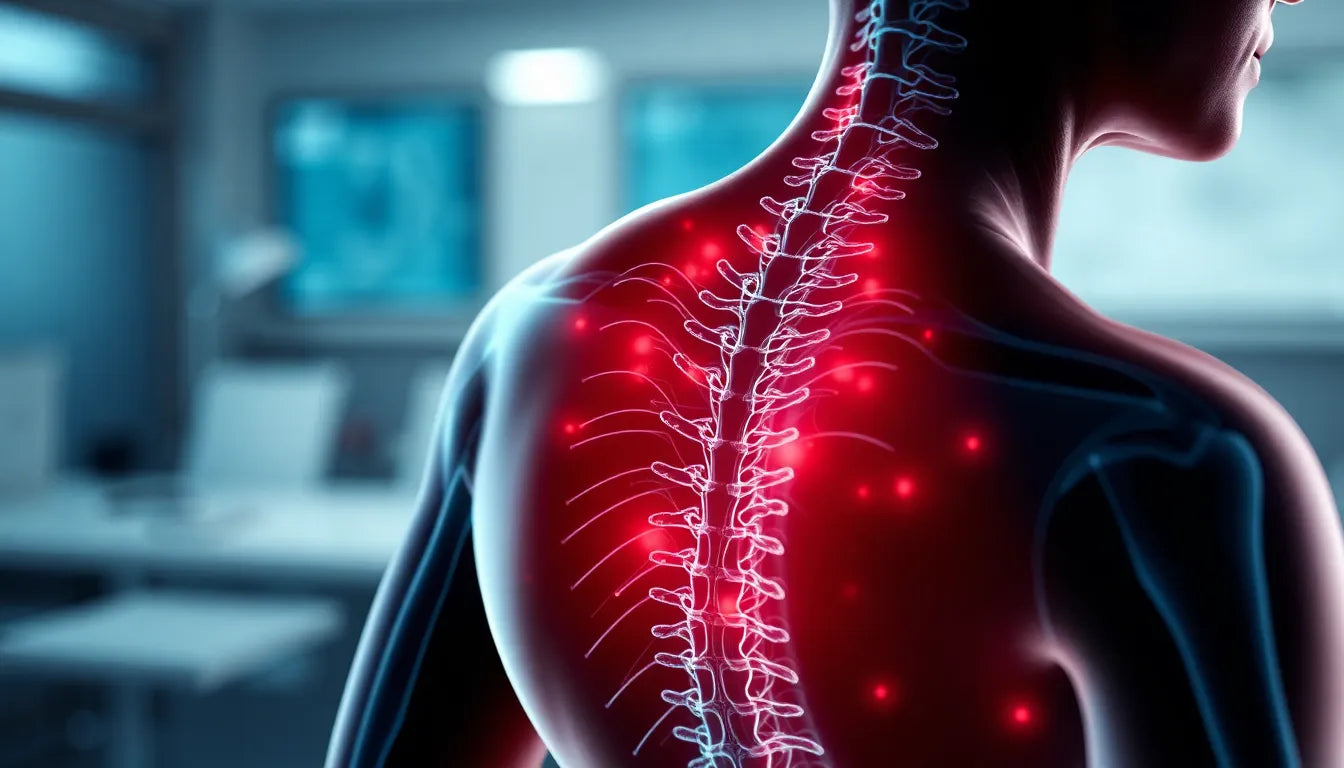For any dog owner, the news that their beloved pet has been diagnosed with a herniated disc can be devastating. The journey from diagnosis to making critical decisions about your dog's future is fraught with emotional turmoil and uncertainty. Imagine watching your once lively companion struggle to move, each step a painful reminder of their condition. This scenario is all too familiar for many pet owners, and it marks the beginning of a difficult path where decisions about treatment and quality of life become paramount.
understanding herniated discs in dogs
A herniated disc in dogs, often linked to Intervertebral Disc Disease (IVDD), is a serious condition that affects the spine. This occurs when the cushioning discs between the vertebrae become displaced or rupture, leading to pain, nerve damage, and sometimes paralysis. The impact on a dog's health and quality of life can be significant, with symptoms ranging from mild discomfort to severe mobility issues. For many dogs, this condition can be managed with a combination of rest, pain relief, and in some cases, surgery. However, the severity and progression of the disease can vary widely, making the decision-making process regarding euthanasia incredibly complex.
Deciding when, or if, euthanasia is the right choice involves a careful blend of medical, ethical, and personal considerations. It’s not just about the physical symptoms your dog exhibits but also about their overall quality of life. Factors such as the ability to enjoy daily activities, the level of pain, and the potential for recovery all play a crucial role in this heart-wrenching decision.
why this topic matters
Understanding when to consider euthanasia for a dog with a herniated disc is crucial for pet owners. It’s about striking a balance between extending life and ensuring a quality of life that is free from suffering. Many owners find themselves torn between the hope of recovery and the harsh reality of their pet’s condition. This decision is deeply personal and should be made with compassion, informed understanding, and often, guidance from veterinary professionals.
The importance of this topic extends beyond the immediate medical implications. It touches on the emotional and ethical responsibilities that come with pet ownership. Knowing when to say goodbye is a decision no pet owner wants to face, but it is sometimes the kindest option when a pet's suffering outweighs their moments of joy. By exploring this topic, we aim to provide clarity and support to those navigating this challenging journey, ensuring decisions are made with the best interests of the beloved pet at heart.
medical management and prognosis for herniated discs in dogs
When a dog is diagnosed with a herniated disc, the treatment pathway can vary significantly based on the severity of the condition. Initially, many veterinarians recommend a conservative approach involving strict rest, pain management, and anti-inflammatory medications. This method aims to alleviate pain and reduce inflammation, giving the body a chance to heal naturally. However, if the dog does not respond to these treatments or if the condition is severe, surgical intervention might be necessary.
Surgery, although often effective, comes with its own set of risks and considerations. The prognosis post-surgery largely depends on whether the dog retains deep pain perception (DPP). Dogs with preserved DPP generally have a good to excellent chance of recovery. On the other hand, those that lose DPP face a more challenging outlook. Studies indicate that approximately 14% of these cases may lead to euthanasia due to severe complications like ascending myelomalacia, a progressive and often fatal condition that affects the spinal cord.
Long-term complications can also arise, such as incontinence and paralysis, even after surgical or medical intervention. These issues can significantly impact a dog's quality of life and the owner's ability to provide care, making the decision about euthanasia more complex.
assessing quality of life for affected dogs
Evaluating a dog's quality of life is critical when considering the future of a pet with a herniated disc. Owners can use various tools to assess their pet's well-being, such as pain scores, mobility checklists, and monitoring daily care needs. These assessments help in understanding whether the dog can still enjoy life despite their condition.
For dogs that experience paralysis or significant mobility issues, adaptive care solutions like wheelchairs and ergonomic aids can offer a chance for a fulfilling life. However, these solutions require a considerable commitment from the owner in terms of time, effort, and often financial resources. It's essential to weigh these factors carefully when deciding on the best course of action for your pet.
emotional and ethical aspects of euthanasia
The decision to consider euthanasia for a dog with a herniated disc is emotionally charged and ethically complex. Owners often grapple with feelings of guilt and grief, questioning whether they are making the right choice for their beloved pet. It's crucial to acknowledge these emotions and seek support from friends, family, or professional networks.
Open discussions with veterinary professionals can provide clarity and guidance during this challenging time. Veterinarians can offer insights into the medical aspects of the condition, helping owners understand the prognosis and potential outcomes. This information, combined with the owner's intimate knowledge of their pet's personality and behavior, is vital in making a compassionate and informed decision.
Ultimately, the choice to say goodbye is deeply personal and should be made with the pet's best interests at heart, ensuring that their remaining days are as comfortable and joyful as possible. By approaching this decision with empathy and understanding, owners can find peace in knowing they have acted with love and care for their cherished companion.
Alternatives to euthanasia: living with a herniated disc
For many dogs diagnosed with a herniated disc, euthanasia is not the only option. There are inspiring stories of dogs living fulfilling lives despite paralysis, thanks to dedicated care and adaptive devices. These stories highlight the resilience of dogs and the commitment of their owners to provide a quality life.
Adaptive devices such as wheelchairs, harnesses, and ergonomic beds play a crucial role in enhancing the comfort and mobility of affected dogs. These aids can significantly improve a dog's ability to move and interact with their environment, allowing them to enjoy activities they love. While these solutions require a considerable investment of time, effort, and sometimes financial resources, they offer a viable path for those who wish to avoid euthanasia.
It's important to remember that while adaptive care can greatly enhance a dog's quality of life, it also requires a strong commitment from the owner. Regular veterinary check-ups, physical therapy, and a supportive home environment are essential components of this care. Ultimately, the decision to pursue these alternatives should be guided by the dog's specific needs and the owner's ability to meet them.
Conclusion and reflection
Deciding when to say goodbye to a dog with a herniated disc is a deeply personal decision that involves weighing medical facts, quality of life considerations, and emotional factors. It is crucial for pet owners to reflect on their values and the specific circumstances of their dog's condition. While the journey may be challenging, approaching it with compassion, informed understanding, and support from veterinary professionals can provide clarity and peace of mind.
Every situation is unique, and what might be the right decision for one pet and owner may not be the same for another. By considering all options, including adaptive care and the potential for a fulfilling life despite limitations, owners can make a choice that honors the bond they share with their beloved pet.
Frequently asked questions
What are the signs that my dog might have a herniated disc?
Common symptoms of a herniated disc in dogs include pain, limping, reluctance to move, and in severe cases, paralysis. If you notice any of these signs, it's important to consult a veterinarian for a proper diagnosis.
How can I determine if my dog's quality of life is compromised?
To assess your dog's quality of life, consider using quality of life scales, observing changes in behavior, appetite, and ability to perform daily activities. Consulting with a veterinarian can also provide valuable insights into your dog's well-being.
What are the risks of surgery for a herniated disc?
Surgery for a herniated disc carries potential risks, including infection, bleeding, and the rare risk of fatal myelomalacia. Discussing these risks with your veterinarian can help you make an informed decision about treatment options.
Can my dog live comfortably with a herniated disc?
Yes, many dogs can live comfortably with a herniated disc through appropriate medical management, adaptive care, and lifestyle adjustments. Wheelchairs, harnesses, and physical therapy are some of the ways to support your dog's mobility and comfort.
When should euthanasia be considered?
Euthanasia should be considered when untreatable pain, severe complications, or extreme loss of quality of life occur. This decision should be made after thorough consultation with a veterinarian, taking into account the dog's condition and the owner's capacity to provide care.
Sources
- WiggleLess. "IVDD FAQ."
- The Rehab Vet. "IVDD Dogs With No Deep Pain."
- Berkeley Dog & Cat Hospital. "IVDD Surgery and Prognosis."
- Frontiers in Veterinary Science. "Prognostic Factors in Canine Acute Intervertebral Disc Disease."
- PetMD. "Spinal Surgery in Dogs."
- SEVNeurology. "Dog Herniated Disc."
- Small Door Veterinary. "IVDD in Dogs."


















